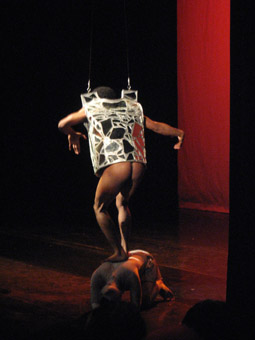 |
Merah photo Phalla San |
This is Merah choreographed and performed by Asri Mery Sidowati, a recent graduate in dance art from the Institut Kesenian Jakarta and one of Indonesia’s emerging choreographers. The unsophisticated work shows a respect for tradition but fortunately does not take the hackneyed route of putting it on a pedestal and placing it in an antagonistic relationship with modernity. Instead we see a valiant attempt to make traditional elements part of her language of expression and not the object. The slow pace of movement and defined silhouettes in Sidowati’s choreography combined with the sound of traditional drums in Arif Susanto’s music provide a tribal, earthy feel, while tradition is also glancingly referenced in her costume. Inspired by Topeng Panji Indramayu (a traditional mask dance) the outfit tightly covers the performer's body from head to toe, designed as a mask but making her an almost amorphous mass.
From the beginning this ever present masked figure introduces a menacing element of uncertainty. Fading light effectively hides Sidowati from view, revealing only the male dancer, Serraimere Bogie Y Koirewoa, frozen in a proud posture—but the knowledge of her presence remains. Soon the lights subtly illuminate her white silhouette in a flamingo-like stance, arms above her head, one foot raised to knee height. With no other distinguishing features, Sidowati’s image is a mystery that heightens the sense of foreboding.
Slowly a low drum beat reverberates to your core and a sprinkling of sounds evocative of the jungle permeate the senses, while the white backdrop is dappled with irregular shaped patches of light radiating out like the leaves of a tree. The shadows speckle Koirewoa as he wriggles, his dexterous fingers creating a mass of writhing worms that in the mottled light appear to multiply and grow, like nature itself.
The stage brightens revealing muscles so tautly held that Koirewoa appears almost skeletal as he gradually unfolds his limbs. His control and focus amplify each small movement into a luscious image. Jutting his neck out and rolling his shoulders back, he strains forward, nose leading like a beak; his elbows pulled back forming wings he becomes a preening bird. He then morphs into one ready for battle as his arms stretch out, fingers pointing high, preparing to charge. The white figure tentatively tries to copy him, seeming soft in comparison as she raises her arms.
Seeing these two 'birds' contrasted, one original and the other a poor imitation, I'm reminded in a flash of Hans Christian Anderson’s The Nightingale. This is a fairytale of an emperor who trades his live nightingale for a mechanical copy, only to find that the machine is far inferior and cannot bring him the same comfort. By presenting a face-off between the natural, embodied in Koreiwoa’s bared body and the artificial, represented by Sidowati’s obscured shape creates a binary opposition, the choreographer underscoring human indifference to rapid climate change and a deteriorating environment.
An angry red seeps into the backdrop as the two figures move towards each other. In slow motion Koirewoa creeps around Sidowati and then clings to her mid-section like a vine. He seems to engulf her, and yet he is powerless as she revolves, carrying him. Having moved the action to her side of the stage, Sidowati, the champion of the 'artificial' is winning, as the growing buzz of electronic sound testifies, drowning out the tribal drumming. To crown it all a hard armor-like vest descends, hovering above the pair. Covered with a mosaic of sharp edged shards of mirror, it glints harshly in the light, its patterns a mockery of the dappled 'tree of light' that earlier framed Koirewoa.
Completing the take-over, Sidowati offers herself as a platform for Koirewoa to climb up and don the vest. He rises high up, precariously perched on her back, and her control is admirable as she steadily holds the crouched position. Once in the vest, Koirewoa transforms into a mechanical bird; his arms jerk and flail robotically. Then he opens the his vest and we observe a spreading of wings, his twisting torso sending out spikes of light, piercing the stage and blinding the audience—creating a sad distortion of the first 'tree'...the synthetic has wiped out the organic.
In Merah the choreographer’s intention to show the gradual eradication of the natural world is simply and perhaps too directly stated, the thematic opposition and its development appearing somewhat naive. However, while not intellectually challenging, the evocative sound score, effective lighting and the physical elements of the production, not least Koirewoa’s expert control, can be appreciated.
Indonesian Dance Festival 2010: Merah, choreographer Asri Mery Sidowati, performers Asri Mery Sidowati, Serraimere Boogie Y Koirewoa, music Arif Susanto, sound Teuku Rifnu Wikana, costumes Ling Ling; Teater Luwes, Jakarta, June 15
10 years ago Melissa Quek began her career as a contemporary dancer in Singapore. In addition to performing, she continues to contribute to the Singapore dance scene as a choreographer and teacher, and is currently Programme Coordinator for the BA(Hons) Dance Programme at LASALLE College of the Arts, Singapore.
© Melissa Quek; for permission to reproduce apply to [email protected]








 back
back